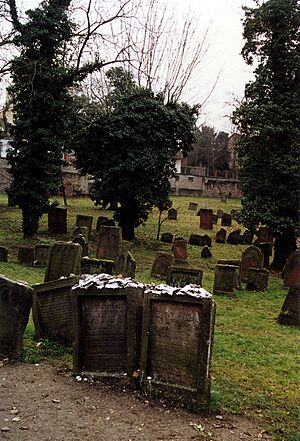Meir of Rothenburg facts for kids
Quick facts for kids Meir of Rothenburg |
|
|---|---|

Tombs of Meir of Rothenburg (left) and Alexander ben Salomon Wimpfen (right) in the Jewish cemetery of Worms
|
|
| Religion | Judaism |
| Personal | |
| Born | c. 1215 Worms, Holy Roman Empire |
| Died | 2 May 1293 Wasserburg am Inn, Bavaria |
Meir of Rothenburg (born around 1215 – died May 2, 1293) was a very important German Rabbi and poet. He was a major writer of tosafot, which are special notes on Rashi's commentary on the Talmud. People also knew him as Meir ben Baruch or by his Hebrew nickname Maharam of Rothenburg. This nickname means "Our Teacher, Rabbi Meir." A famous rabbi named Menachem Meiri called him the "greatest Jewish leader" of his time in the region of France and Germany.
Contents
Rabbi Meir's Life Story
Early Life and Learning
Rabbi Meir was born in the city of Worms between 1215 and 1220. His first teacher was his own father, who came from a long line of rabbis. He continued his studies in Würzburg with Isaac ben Moses of Vienna. Then, he moved to France and stayed there until 1242. In France, his teachers included Yechiel of Paris and Samuel of Évreux.
While in Paris, he sadly witnessed the burning of the Talmud on June 17, 1242. This was a terrible event where many holy Jewish books were destroyed. After this, he settled in Rothenburg ob der Tauber and opened a yeshiva, which is a Jewish school, in his own home. After his father passed away in 1281, Rabbi Meir moved back to Worms.
Challenges and Imprisonment
In 1286, Rudolf I, who was the King of the Romans, changed the rules for Jewish communities. He declared them servi camerae regis, which meant "serfs of the treasury." This allowed the king to tax Jewish communities directly. However, local nobles could still tax them too. This made life very hard for Jewish people, as they had to pay many taxes.
Because of these heavy taxes, Rabbi Meir decided to leave Germany. Many other Jewish families and their followers also left. But Rabbi Meir was captured in the mountains of Lombardy. A person who had converted from Judaism to Christianity recognized him. Rabbi Meir was then put in prison in a fortress near Ensisheim in Alsace.
People tried to pay a very large sum of money, about 23,000 marks of silver, to free him. This money was raised by Asher ben Jehiel, another important rabbi. However, Rabbi Meir refused to be ransomed. He was worried that if he was freed by paying a ransom, it would encourage others to kidnap more rabbis for money. He even made a ruling based on Jewish law about his own capture.
Rabbi Meir stayed in prison for seven years. He passed away there on May 2, 1293. Fourteen years after his death, a man named Alexander ben Salomon Wimpfen paid a ransom to get Rabbi Meir's body. Alexander was later buried right next to Rabbi Meir in the Jewish cemetery of Worms.
Other Interesting Facts
According to Yaakov ben Moshe Levi Moelin, Rabbi Meir was very good at understanding and interpreting dreams.
Also, a student of Rabbi Meir named Meir HaKohen wrote a famous commentary on Maimonides' Mishneh Torah. This commentary is called Hagahot Maimoniyot.
Rabbi Meir's Writings
Rabbi Meir did not write one single big book. Instead, he wrote many notes, comments, explanations, and poems. He also wrote about 1,500 responsa. Responsa are answers to questions about Jewish law. His student, Rabbi Asher ben Jehiel, later put many of his teachings into an organized form.
- Responsa: His responsa are very important for students who study the Talmud. They also help us understand Jewish life and customs from his time. They show us how German Jews suffered from the unfair rules of princes and from high taxes. These responsa also include rulings from other rabbis from his time and earlier.
- Commentaries: Rabbi Meir was known as a Tosafist. This means he wrote special notes called Tosafot on the Talmud. He wrote a commentary on the Talmudic tractate (section) called Yoma. His notes are also quoted in the Tosafot on other parts of the Talmud. He also wrote commentaries on parts of the Mishnah called Tohorot and Zeraim.
- Poems: Rabbi Meir wrote many religious poems, called "piyyutim." One famous poem is Sha'ali Serufa Ba'eish. This was a kinnah, which is a sad poem or lament, written about the burning of the Talmud.
- Jewish Law: He also wrote about specific areas of Halakha, which is Jewish Law. Some of his writings include:

